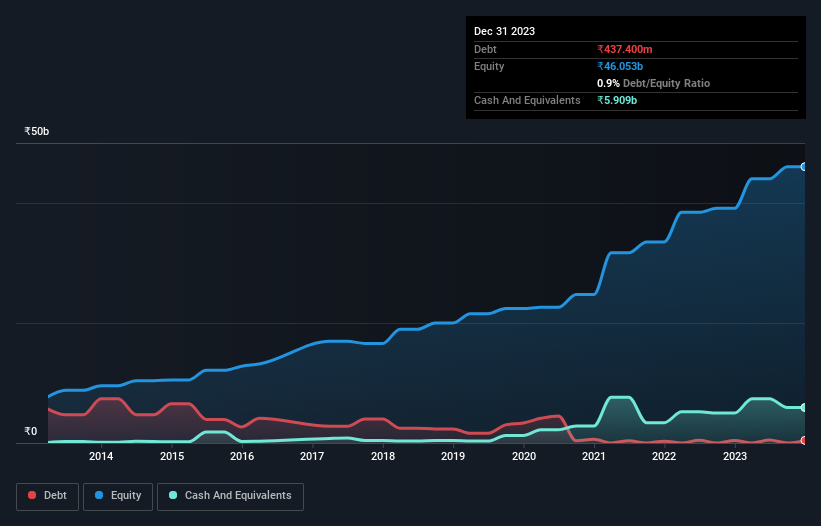We Think Supreme Industries (NSE:SUPREMEIND) Can Stay On Top Of Its Debt

Legendary fund manager Li Lu (who Charlie Munger backed) once said, 'The biggest investment risk is not the volatility of prices, but whether you will suffer a permanent loss of capital.' When we think about how risky a company is, we always like to look at its use of debt, since debt overload can lead to ruin. We can see that The Supreme Industries Limited (NSE:SUPREMEIND) does use debt in its business. But the more important question is: how much risk is that debt creating?
When Is Debt Dangerous?
Generally speaking, debt only becomes a real problem when a company can't easily pay it off, either by raising capital or with its own cash flow. Ultimately, if the company can't fulfill its legal obligations to repay debt, shareholders could walk away with nothing. However, a more usual (but still expensive) situation is where a company must dilute shareholders at a cheap share price simply to get debt under control. Having said that, the most common situation is where a company manages its debt reasonably well - and to its own advantage. When we examine debt levels, we first consider both cash and debt levels, together.
Check out our latest analysis for Supreme Industries
What Is Supreme Industries's Debt?
You can click the graphic below for the historical numbers, but it shows that as of September 2023 Supreme Industries had ₹437.4m of debt, an increase on ₹420.5m, over one year. However, it does have ₹5.91b in cash offsetting this, leading to net cash of ₹5.47b.

How Strong Is Supreme Industries' Balance Sheet?
The latest balance sheet data shows that Supreme Industries had liabilities of ₹10.1b due within a year, and liabilities of ₹1.54b falling due after that. Offsetting this, it had ₹5.91b in cash and ₹5.55b in receivables that were due within 12 months. So these liquid assets roughly match the total liabilities.
Having regard to Supreme Industries' size, it seems that its liquid assets are well balanced with its total liabilities. So it's very unlikely that the ₹503.9b company is short on cash, but still worth keeping an eye on the balance sheet. Despite its noteworthy liabilities, Supreme Industries boasts net cash, so it's fair to say it does not have a heavy debt load!
On top of that, Supreme Industries grew its EBIT by 44% over the last twelve months, and that growth will make it easier to handle its debt. The balance sheet is clearly the area to focus on when you are analysing debt. But ultimately the future profitability of the business will decide if Supreme Industries can strengthen its balance sheet over time. So if you're focused on the future you can check out this free report showing analyst profit forecasts.
Finally, while the tax-man may adore accounting profits, lenders only accept cold hard cash. While Supreme Industries has net cash on its balance sheet, it's still worth taking a look at its ability to convert earnings before interest and tax (EBIT) to free cash flow, to help us understand how quickly it is building (or eroding) that cash balance. In the last three years, Supreme Industries's free cash flow amounted to 30% of its EBIT, less than we'd expect. That weak cash conversion makes it more difficult to handle indebtedness.
Summing Up
We could understand if investors are concerned about Supreme Industries's liabilities, but we can be reassured by the fact it has has net cash of ₹5.47b. And we liked the look of last year's 44% year-on-year EBIT growth. So is Supreme Industries's debt a risk? It doesn't seem so to us. When analysing debt levels, the balance sheet is the obvious place to start. However, not all investment risk resides within the balance sheet - far from it. These risks can be hard to spot. Every company has them, and we've spotted 1 warning sign for Supreme Industries you should know about.
At the end of the day, it's often better to focus on companies that are free from net debt. You can access our special list of such companies (all with a track record of profit growth). It's free.
New: Manage All Your Stock Portfolios in One Place
We've created the ultimate portfolio companion for stock investors, and it's free.
• Connect an unlimited number of Portfolios and see your total in one currency
• Be alerted to new Warning Signs or Risks via email or mobile
• Track the Fair Value of your stocks
Have feedback on this article? Concerned about the content? Get in touch with us directly. Alternatively, email editorial-team (at) simplywallst.com.
This article by Simply Wall St is general in nature. We provide commentary based on historical data and analyst forecasts only using an unbiased methodology and our articles are not intended to be financial advice. It does not constitute a recommendation to buy or sell any stock, and does not take account of your objectives, or your financial situation. We aim to bring you long-term focused analysis driven by fundamental data. Note that our analysis may not factor in the latest price-sensitive company announcements or qualitative material. Simply Wall St has no position in any stocks mentioned.
About NSEI:SUPREMEIND
Supreme Industries
Engages in the manufacture and sale of plastic products in India.
Flawless balance sheet established dividend payer.


